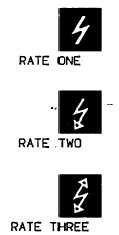TM 1-1510-224-10
(6)
LX/I (green). Indicates that the receiver is
inhibited by the XMIT INH input during transmission by
communications transmitters. No lightning may be
received during this condition.
(7)
LH/H (green). Indicates that heading input
has been deselected by the HDG VALID input.
(8)
LX/C (green). Indicates that the system is
in the self-calibration mode. This will revert to the
selected mode approximately 10 seconds after power has
been applied.
(9)
LX/L (green). The number of computed
lightning rate symbols exceeds the capability of the
display system.
(10)
LX (green). Indicates that the system is in
the normal operating mode.
NOTE
If two or more of the above situations
are true at the same time, the
annunciation which is highest on the
above list will be displayed.
NOTE: EACH RATE SYMBOL REPRESENTS THE
CENTER OF AN 18-MILE DIAMETER AREA
OF LIGHTNING ACTIVITY.
AP015461 C
Figure 3-33. Lightning Rate of Occurrence Symbols
e.
Self
Calibration
Mode.
During
approximately the first 8 seconds after power is applied,
the system performs a self-calibration process to cancel
out variations in antenna gain and cable loss (LX/C will be
displayed on the EHSI). As soon as this is complete, the
letter C will be removed from the display. If strong
interfering signals outside the aircraft, or equipment
malfunction prevent the calibration of the system, it will
revert to preset calibration factors, in which case the C
will not be removed from the display. In this case the
operator should select the TST mode and evaluate the
test display. Interference signals can be caused by other
systems on the aircraft, by adjacent ground installations
such as power transformers, or by nearby aircraft. If
sources outside the aircraft cause the C to remain
displayed, they will not be present after takeoff, and the
LSS mode selector switch should be switched to OFF and
set back to the LX mode to force recalibration for greater
accuracy. If the C display persists after takeoff, TST
mode should be selected again to re-evaluate the system.
f.
Self-Test.
1.
Range switches (radar control panel,
fig. 3-29) Select range of 50 nautical
miles or greater.
2.
Lightning sensor system (LSS) mode
selector switch (radar control panel)
CLR/TST. Verify that all lightning
rate symbols are erased from display.
NOTE
After 3 or 4 seconds, simulated
lightning test pulses are sent to the
display.
3.
Verify that a rate symbol is displayed
at 25 nautical miles, at 45 degrees to
right of center. This symbol will take
approximately 5 to 7 seconds to build
up.
NOTE
This
time
will
be
extended
to
approximately 15 seconds if TST is
selected immediately from OFF, due
to lightning processor initialization.
The symbol's range may vary by as much as 5
nautical miles if strong local interference is
present.
4.
Verify that a magenta lightning alert
symbol is displayed at maximum
selected range, at 45 degrees right of
center. This must remain on display
for 3 to 7 seconds.
5.
To restart the test, switch to LX mode
and back to CLR/TST mode.
3-86


